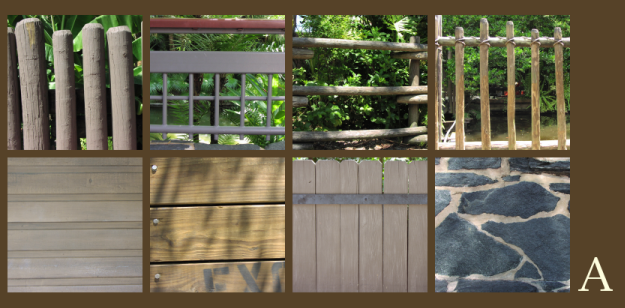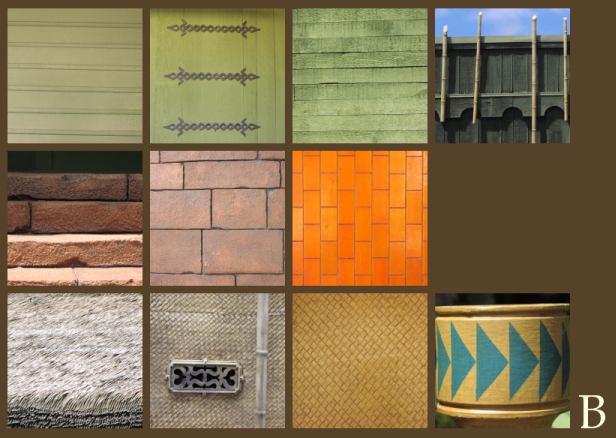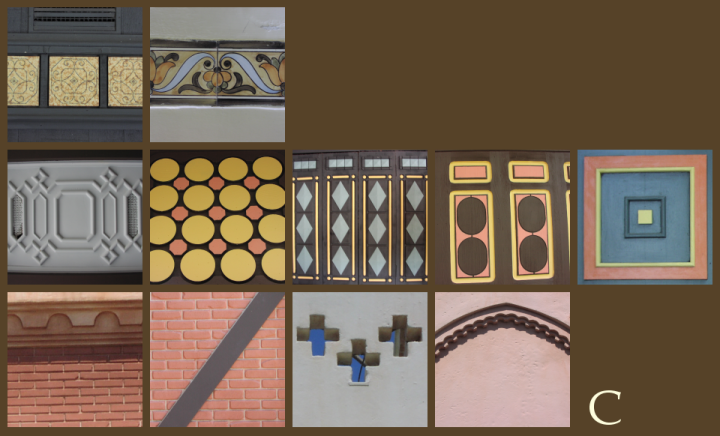What follows is an extensive, visually oriented view of Adventureland based on the concept of getting down to the level of colors and textures instead of things like building shapes and placement. I did this by photographing literally every unique surface in Adventureland and then tediously sorting out the most representative of these "swatches", grouping them with no bias towards location and instead focusing on aesthetic unity. This allowed me to burrow down past the architectural and into color, texture, and pattern, the basest of reasons the Magic Kingdom works. It also allowed me to "get inside" Adventureland in a way I never had before and indeed I learned a lot about how the place was put together by the WED designers of the 1970's; it was like literally reverse engineering the design of the areas. I focused exclusively on remaining 1971 features for the sake of integrity and avoided going inside if I could help it.

GROUPING A:
This grouping represents what I have come to call "base Adventureland" and includes features from the Adventureland Bridge, the Swiss Family Treehouse, and the Jungle Cruise, which are indeed all aesthetically unified. I had suspected this during the picture taking process but this didn't come together until later; I had grouped everything into plain categories and everything that was left was easy to pull together into Grouping A.
Grouping A's aesthetic mode is what welcomes you upon your arrival in Adventureland, and it's important to note that the Adventureland Veranda is not aesthetically consistent with it. Instead the fences and guarding facing the treehouse, the treehouse itself and the Jungle Cruise seem to be aesthetically unified to suggest that these features which constitute the southernmost portions of Adventureland are "the jungle", the beaconing wilderness which man has not tamed. This is why the Jungle Cruise and the treehouse's waterways are almost intertwined, and in the early days one could look out from the top of the treehouse and observe the Jungle Cruise's Cambodian Ruins.
Consider also that Adventureland and Frontierland, the areas which represent man's attempts to conquer nature, are the only areas of the park where upon entering them from their main entrance we are not surrounded by manmade structures to the left and right. In Adventureland and Frontierland the manmade buildings are forced to only one side of the pathway; the other side opening up to an untamed forest and river. This is so well done it cannot be accidental.
This "base aesthetic" of Adventureland is made up of earthtones, rocks, and wood, of open, impermanent barriers holding back the wilderness. It is the mode of Adventureland which most represents what existed there before "colonists" arrived.

GROUPING B:
The Sunshine Pavilion, or, the Tropical Serenade entrance area, facade, and Sunshine Tree Terrace. This beautiful if overlooked area follows the rules of American Mid-Century Tiki Modern pretty closely and so is perhaps somewhat less interesting that the other areas of Adventureland but deserves consideration regardless. The Tiki Room itself seems to be made of green wood, held together with horizontal woven metal bands, placed on a foundation of rough-hewn red clay bricks. Everything above the foundation is lumber, logs and bamboo lashed together, sometimes brightly painted. As the green wood creeps past the Sunshine Tree Terrace northward towards Frontierland it gains some bamboo and decorative accents which transitions nicely into the shingles and gingerbread details of Frontierland, which the area once flowed seamlessly into.
The bright orange tiles below the serving counter of the Sunshine Tree Terrace are the only distinctly modern visual components of Adventureland. The decorative A/C vents (middle bottom row) and hanging lotus lanterns (not pictured) rank amongst some of Walt Disney World's most delightful details.

GROUPING C:
This area is what I would call "Downtown Adventureland", a ecclectic grouping of shops which form the "hub" of Adventureland into which the Aladdin spinning ride has today been thrust. The natives of adventureland seem to be partial to bricks and stone as much of their architecture seems to thrive on it; this connects Downtown Adventureland to the Sunshine Pavillion aesthetically. Paneled, ornately painted wood details characterize this portion of Adventureland, as does hand-crafted walls made of clay or mud with obliquely if somewhat tactily present Moorish and Persian influences.
I used to consider Grouping C (Downtown) to be indistinguishable from Grouping E - G (Veranda), but they are in fact quite obviously unrelated architecturally and conceptually. These Adventureland natives love bricks and sculpted, ornate walls and details, in contrast to the colonial architecture as embodied by the Veranda, which relies on Western-style mass-produced lumber, sheet metal, and gingerbread accents. Grouping C is further differentiated by exhibiting the use of forced perspective much more markedly than the buildings in Grouping E - G, and this use of reduced scale doesn't really begin in Adventureland until one passes west of the Adventureland breezeway, along with the first inklings of hand-formed clay walls and tiles and wood details. The Breezeway is a pivot on which turns the whole aesthetic mode of Adventureland, and this shift articulates a shift away from the Veranda complex's implied colonial architecture - which ties it to Main Street, USA - and towards the more rough-hewn, natural resources used as Adventureland travels west,culminating in the Sunshine Pavilion's exposed bamboo struts and supports and extensive use of thatch.

GROUPING D:
Some of Adventureland's most interesting paving surfaces.

GROUPING E:
The 'basic elements' of the construction of the Adventureland Veranda, with a strong accent on brightly painted woods. Note also the use of bricks, which both recalls Main Street and prefigures the bricks of Grouping C, which culminates in the red earth block foundation of the Tropical Serenade building, which has the largest and most irregular bricks of all. Also note the use of corrugated sheet metal, a Western invention which is used most prominently as a roofing material and which is also used on the roof of the Jungle Cruise boathouse, another but even less elaborate colonial structure. Adventureland articulates its' narrative of the white man in an exotic land even through its' use of building materials, and both the Jungle Cruise's outpost and the Veranda's little colonial village use lumber, corrugated metal roofing and Victorian gingerbread details.
Note also the use of wood shingles; shingles recur everywhere in the Magic Kingdom except for Adventureland, where cruder things must be substituted, and Tomorrowland, where the 1971 structures were so abstracted that they may not even have any use for roofs. But Disney visually codes shingled structures as being "cozy" throughout the park, and the single occurance of it here, in Adventureland on the east side of the Breezeway is noteable. The structure it is attached to also includes patinaed dormers and a skylight; perhaps the last and most ornate hurrah of the Western influence before the whole aesthetic strategy changes west of the Breezeway?
GROUPING F:
Mass-produced, gentrified Victorian Gingerbread used on the Veranda, which aesthetically transitions Adventureland from Main Street USA and marks this architecture as the product of the same Western culture and her value in visually pleasing but structurally worthless frills; compare these patterns to those seen in row two of Grouping C, the "native" equivalent, which are always cruder and handmade.
GROUPING G:
Structural details throughout the Veranda recall both caribbean and New Orleans influences; indeed, some of these same details can be found in New Orleans Square at Disneyland. The Veranda uses open seating areas and gusty, open-latticed balconies to set the scene and create an atmosphere of gentility compared to the tight, functional balconies and catwalks we see later in Downtown Adventureland. The colonial architecture also includes glass window panes, which vanish immediately upon crossing the Breezeway into the native-settled area. The glass recalls especially strongly the Crystal Palace, the most extensive use of glass in the entire Magic Kingdom but one which is ironically perched: it is a greenhouse situated right on the outer edge of Adventureland, where glass is a scarce commodity and plants cannot be contained by mere buildings, only held back with simply constructed wooden barriers.
Compare Groupings E, F and G with Grouping A and recall that these two aesthetic modes of Adventureland directly parallel each other in the main entrance corridor just beyond the bridge and appear to be aesthetically unified, but in reality are quite diverse. This is the brilliance and complexity of Disney's design here, to be diverse and eclectic but apparently homogenous. But just beneath the surface of Adventureland are tensions, of different cultures who beat back the brush and ultimately collided, civilization vs civilization and all against nature. This dynamic is best and most extensively manifested in the Jungle Cruise, the anchor of Adventureland, where nature reclaims explorer base camps, pits native cultures against invaders with their machines and machine-made materials, and ultimately parts to reveal the ruins of an ancient civilization she had long ago swallowed up.
This is the core message of Adventureland: that man may become shipwrecked and build civilzation anew in a tree, that he may venture into the jungle and face untold dangers, that he may even influence the animal world to mimic his language and song. But nature wins the struggle in Adventureland every time, manifested at a macro level in the failure of whole civilizations and a micro level of explorer's tents and crashed airplanes. We return from the jungle every time, retreat from nature back to the colonial boathouse, awed but defeated. The Gods of Polynesia ultimately silence of enchanted revelers of the Tiki Room, and even the Swiss Family is eerily absent from their family home.
The Swiss Family, I'm sure, is just like their counterparts far below on the street level, those colonists and natives who are lurking conveniently just out of sight, just beyond our grasp. For while the rest of the Magic Kingdom is all about inclusiveness and belonging, in Adventureland we encounter a narrative of a place where we can never belong. Those Cambodian ruins out in the jungle, invaded by explorer boats, contemplated by that Swiss Family from their jungle lookout, tell the true ending of this unfolding narrative, that the citizens of Main Street USA may wish to contain the jungle foliage in their greenhouses and crystal palaces and ornate planters, but this is one area that will never be fully civilized.


